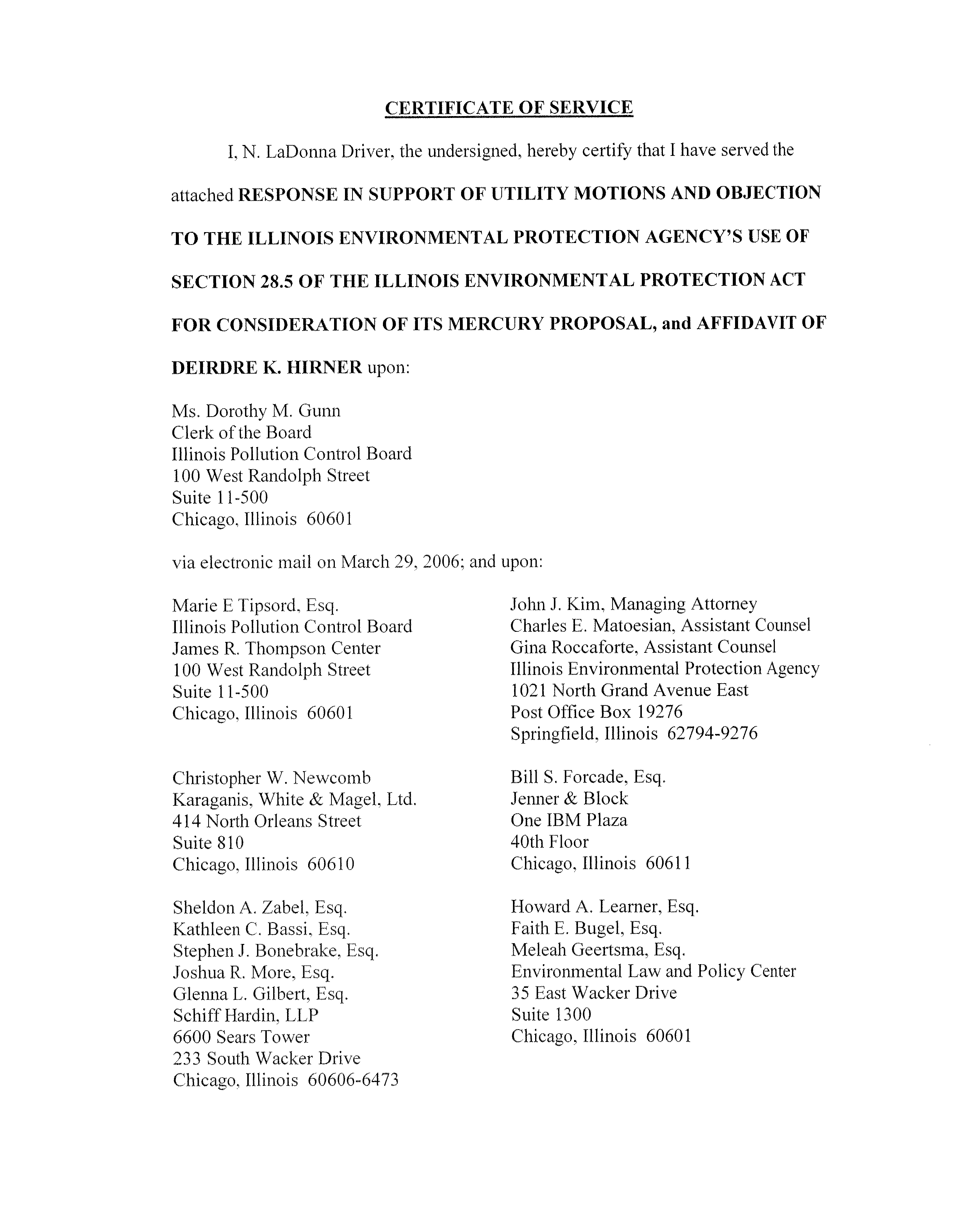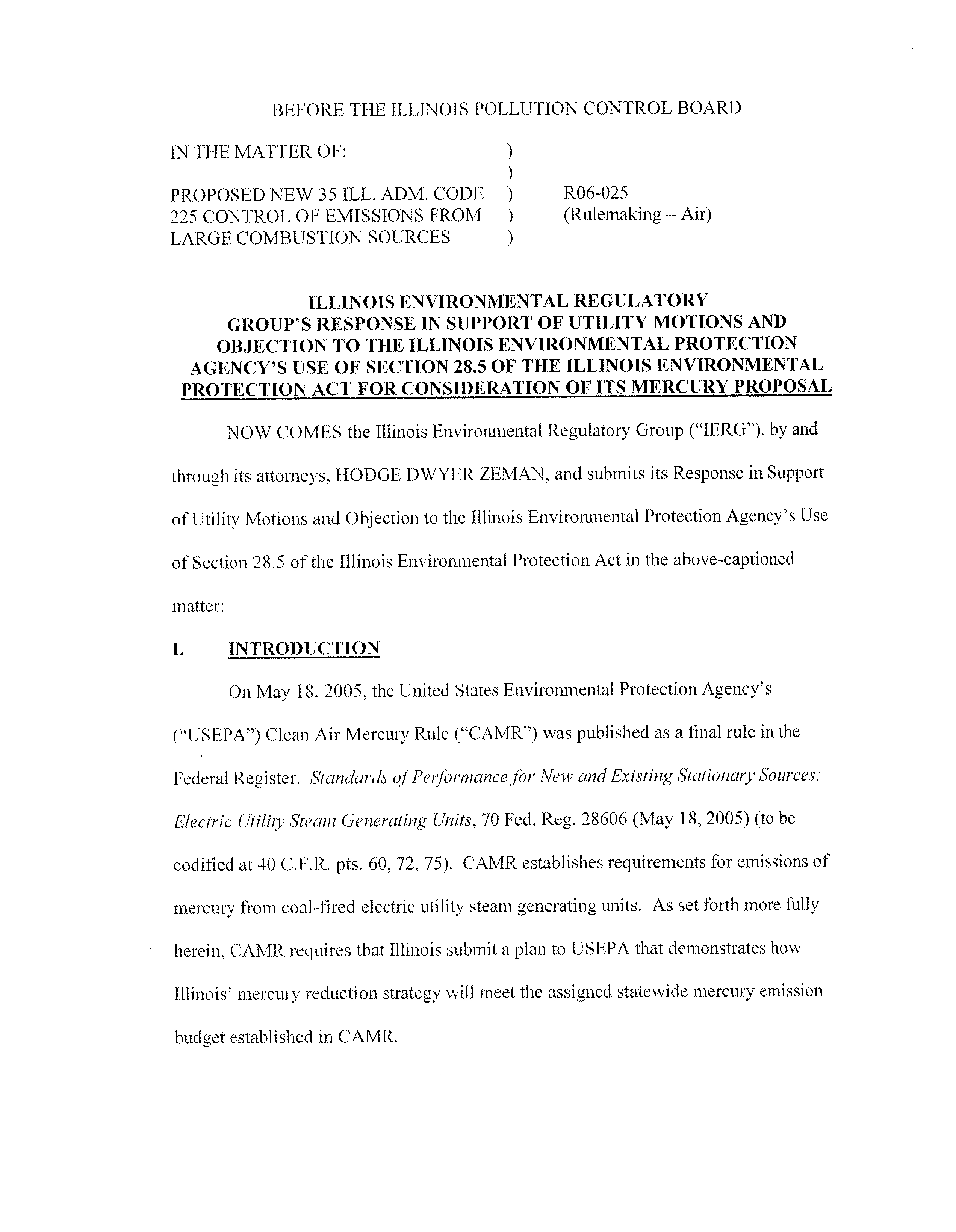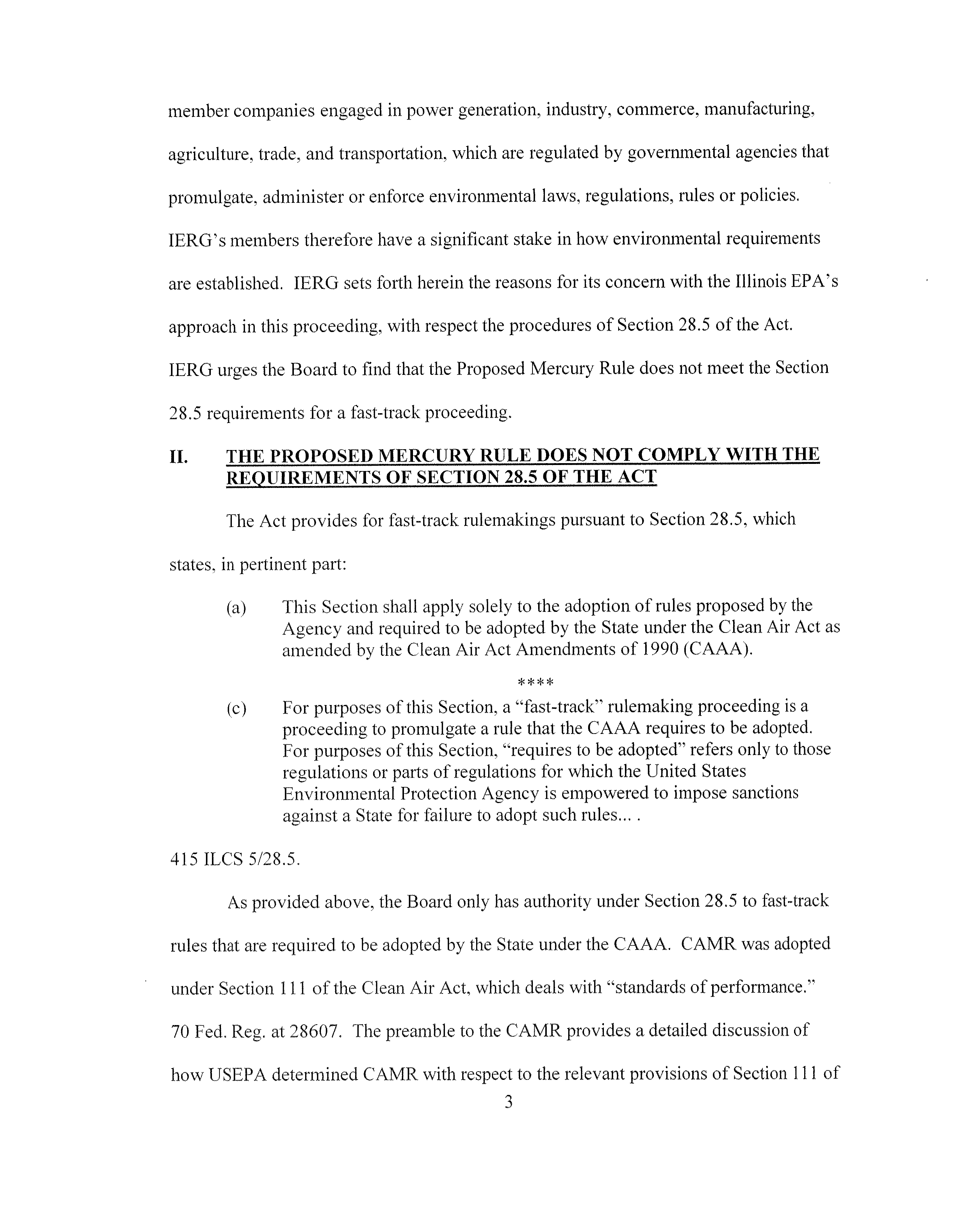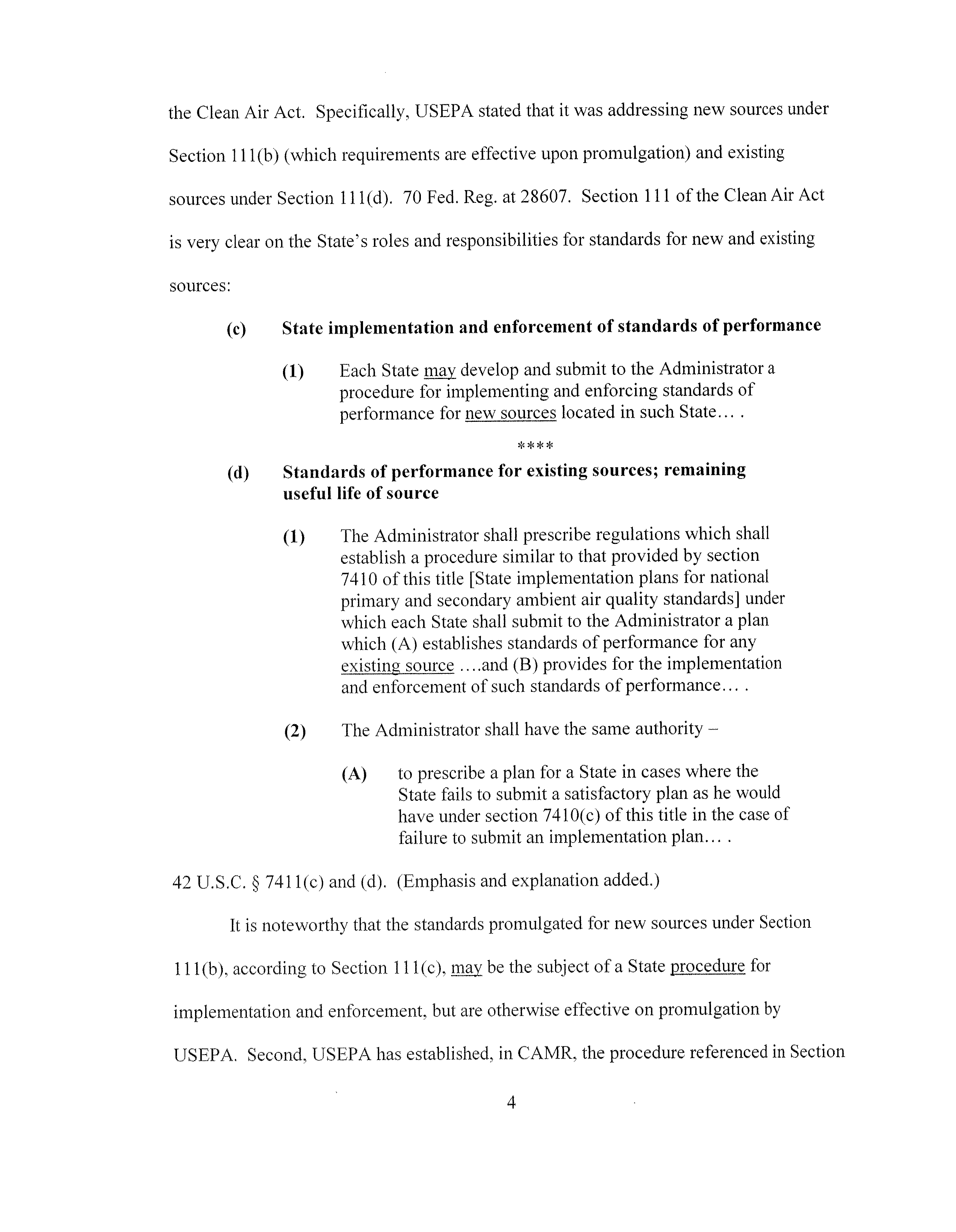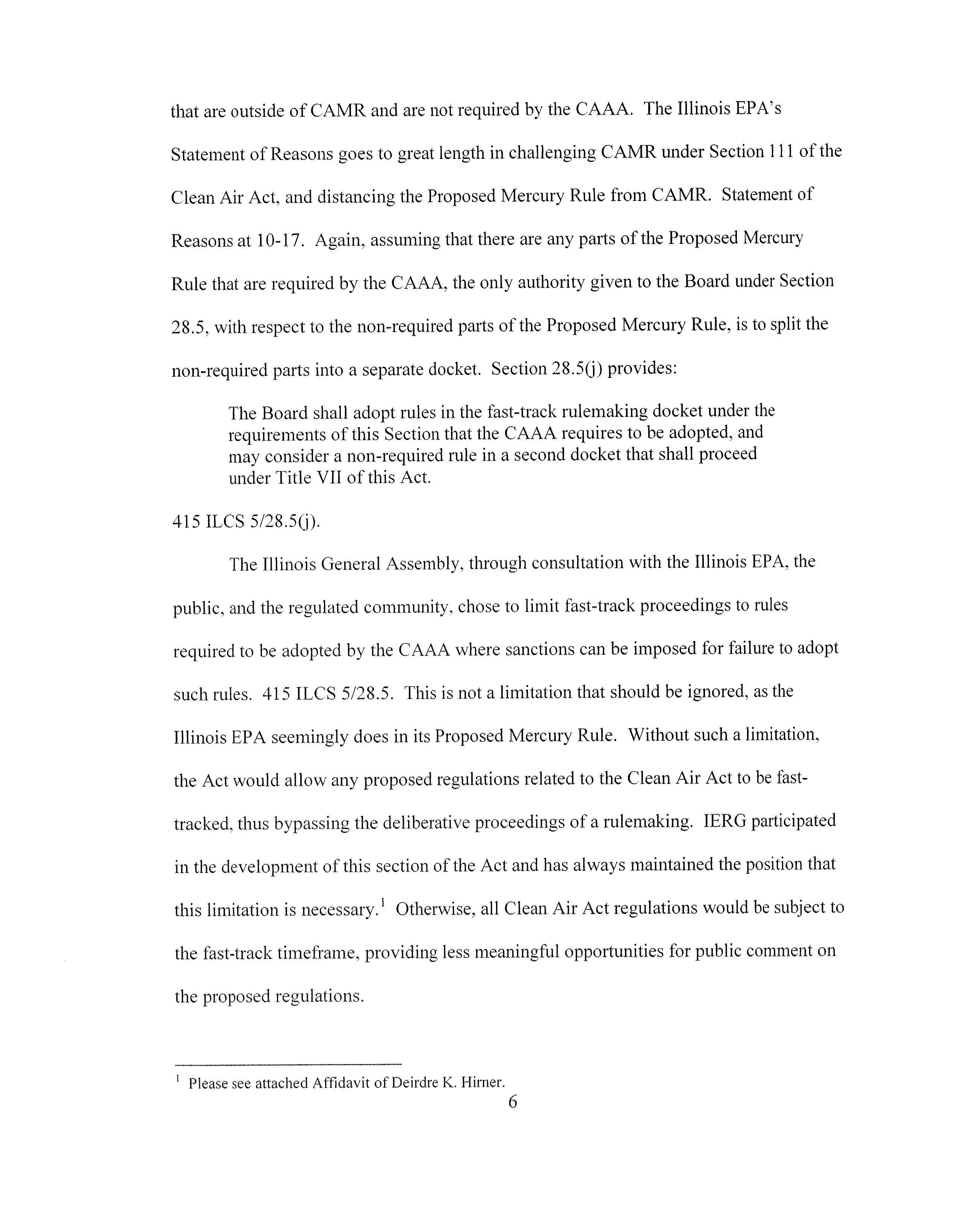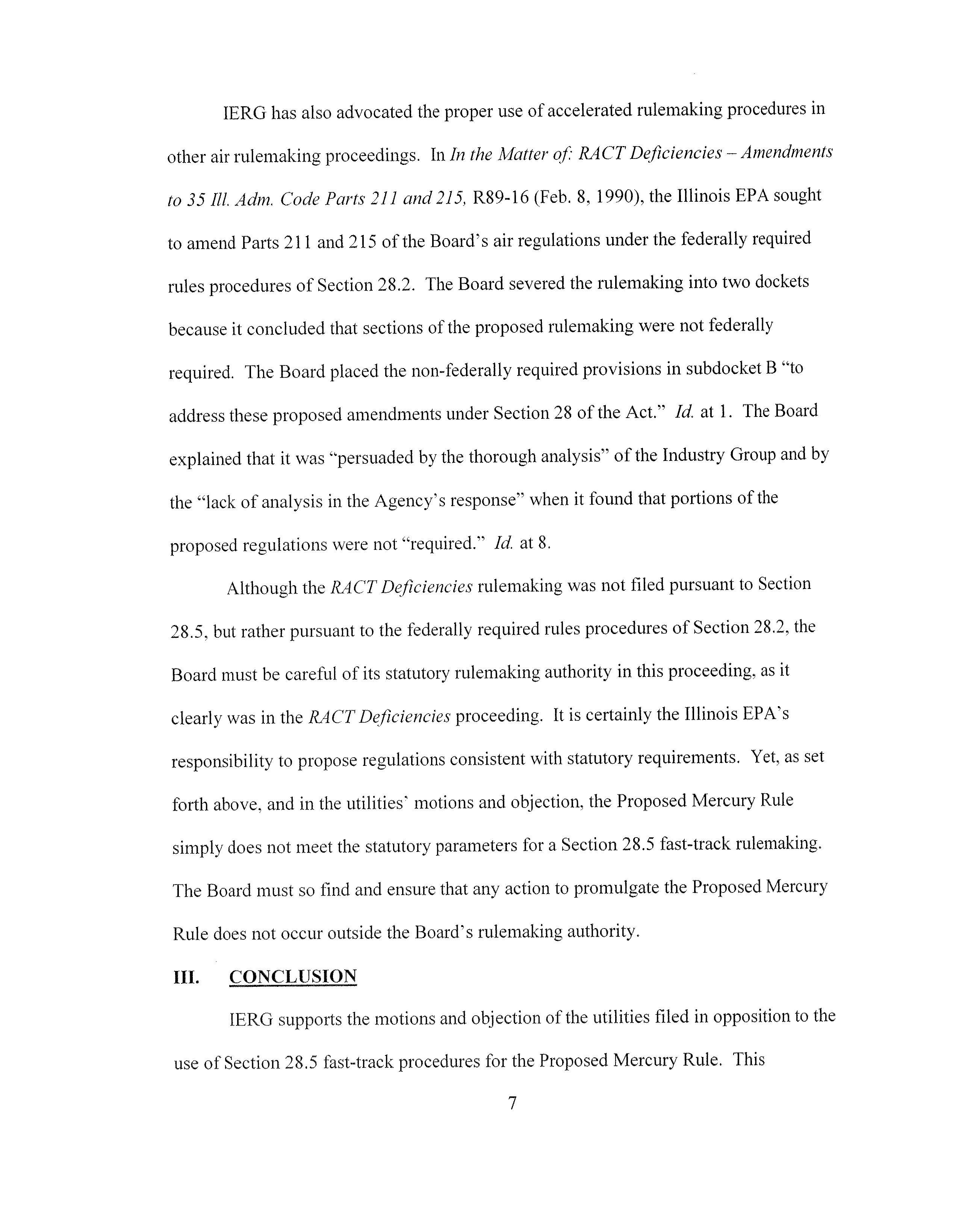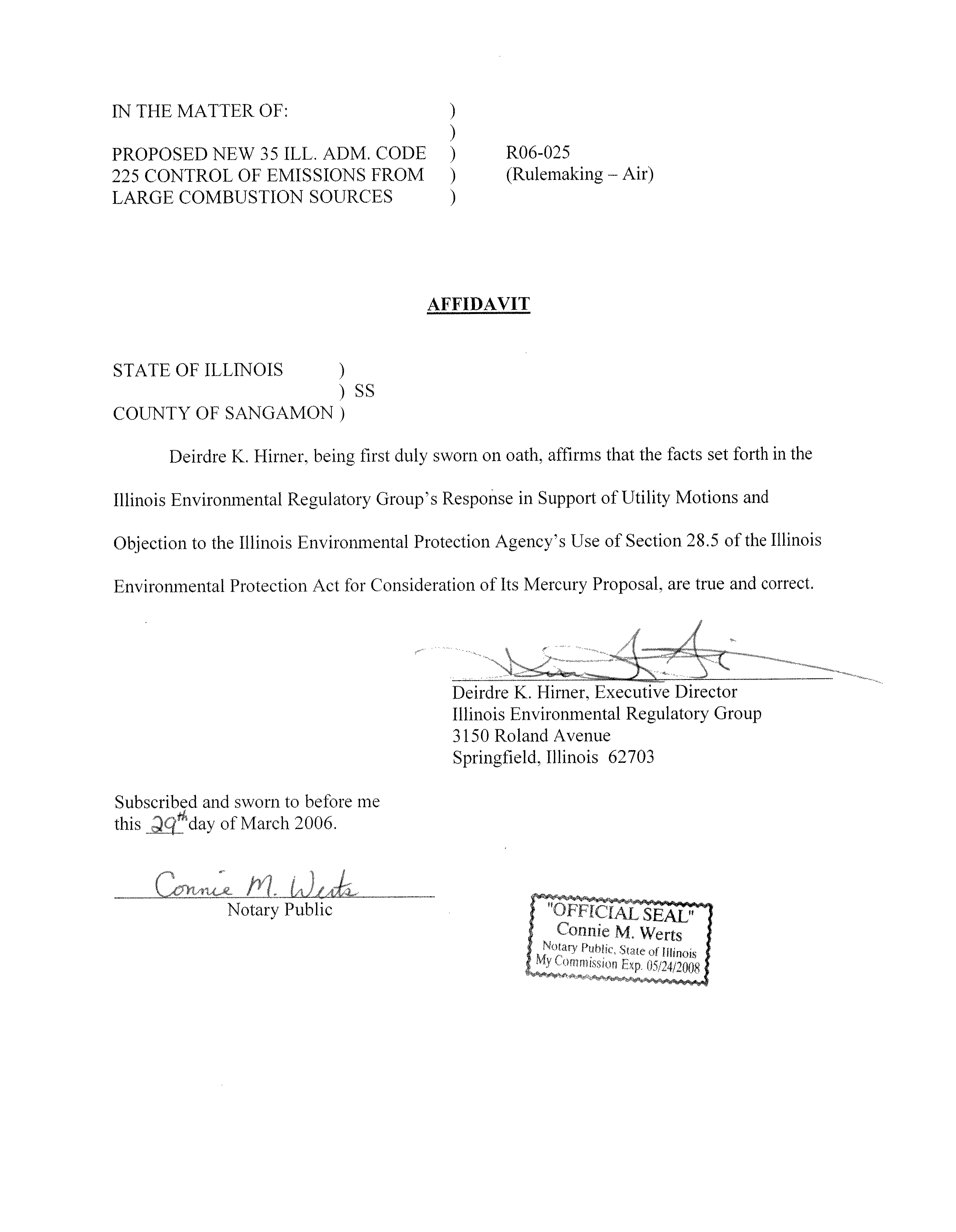BEFORE TILE
ILLINOIS POLLUTION CONTROL BOARD
IN THE MATTER OF:
PROPOSED NEW 35 ILL. ADM. CODE
225 CONTROL OF EMISSIONS
FROM
LARGE COMBUSTION SOURCES
R06-025
(Rulemaking -- Air)
)
)
)
NOTICE OF FILING
TO: Ms. Dorothy
M. Gunn
Clerk of
the Board
Illinois Pollution Control Board
100 West Randolph Street
Suite I1-500
C hicago, Illinois 60601
(VIA ELECTRONIC,
MAIL)
Marie E. Tipsord, Esq.
Illinois Pollution Control
Board
James R.
Thompson Center
100 West Randolph Street
Suite 11-500
Chicago, Illinois 60601
(VIA FIRST CLASS
MAIL)
(SEE PERSONS ON
ATTACHED SERVICE LIS
the I
MO
at I have
today filed with the Office of the Clerk of
and a
RESPONSE IN SUPPORT OF UTILITY
PROTEcTIO
VIRONMENTAL
THE ILLINOIS
DERATION OF
ITS
Regulatory
Group, copies of wh
b ehalf of
th served upon
d ,
ILLINOIS ENVIRONMENTAL
REGULATORY GROUP,
By: /s/ N. LaDonna Driver
One of Its Attorney
Post Office Box 577
S pringfield, Illinois 62705-5776
(217) 523-4900
THIS
FILING SUBMITTED ON
ELECTRONIC FILING, RECEIVED, CLERK'S OFFICE, MARCH 29, 2006
OF SERVICE
aDonna D
gned,
hereby certify that I have served the
attached RESPONSE
IN SUPPORT OF UTILITY MOTIONS
AND
OBJECTION
TO THE ILLINO
ENVIRONMENTAL PROTECTION AGENCY'S
USE OF
SECTION
28.5 OF THE ILLINOIS ENVIRONMENTAL.
PROTECTION ACT
FOR CONS
pon:
Ms. Dorothy M. Gunn
Clerk of the
Board
tution Control Board
100 West Rando
Suite 11-500
C hicago, Illinois 60601
E RCURY PROPOSAL, and AFFIDAVIT OF
via electronic
mail on March 29, 2006; and upon:
R. Thompson
Cen
100 West
Randolph Street
1-500
60601
John J. Kim, Managing Attorney
Charles E. Matoesian, Assistant
Counsel
Gina Roecaforte,
Assistant Counsel
Illinois Environmental
Protection Agency
1 021 North Grand Avenue
Post Office Box 19276
nois 62794-9276
Christopher
W. Newcomb
Karaganis, White &
414 North Orleans Street
Suite 810
Chicago,
Illinois
S heldon A. Zabel, Esq.
K athleen C. Bassi,
hen J. Bonebrake,
Esq.
hua R. More, Esq.
Glenna 11. Gi lbert,
Schiff Hardin, LLP
6600 Sears Tower
233 South
Wacker rive
B ill S. Forcade,
Jemi.er
& Block
One IBM Plaza
40th Floor
Chicago, Illinois 60611
Howard A. Learner,
Faith. E. Bugel, Esq.
Meleah Geertsma, Esq.
Chicago, Illinois 60601
Policy Center
Chicago, Illinois 60606-6473
ELECTRONIC FILING, RECEIVED, CLERK'S OFFICE, MARCH 29, 2006
. Harley, Esq.
Chicago Legal Clinic
205 West Monroe
Street
4th Floor
Chicago, Illinois 60606
William
A. Murray
Regulatory Affairs Manager
Office of Public Utilities
800 East Monroe Street
Springfield, Illinois
62757
James 'T. Harrington, Esq.
David Rieser, Esq.
McGuire Woods LLP
77
W. Wacker Drive
Suite 4100
Chicago, Illinois 60601
S. David
Farris
Manager,
Environmental, Health & Safety
Office of Public Utilities
201 East Lake Shore Drive
Springfield, Illinois 62757
by depositing said documents in the United States
Mail, postage prepaid, in Springfield,
Illinois, on March 29, 2006.
/s/ N. LaDonna Driver
N. LaDonna Driver
:001/R
Dockets/Fil/COS - ROCS-25 Response in Support of Utilities Motion to IEPA's Proposal -
KDH NLD
ELECTRONIC FILING, RECEIVED, CLERK'S OFFICE, MARCH 29, 2006
BEFORE
THE ILLINOIS POLLUTION
CONTROL, BOARD
IN THE
MATTER OF:
PROPOSED NEW 35
ILL. ADM. CODE
225 CONTROL OF
EMISSIONS FROM
LARGE COMBUSTION
SOURCES
R 06-02 5
)
(Rulemaking
ILLINOIS
ENVIRONMENTAL REGULATORY
GROUP'S
RESPONSE IN SUPPORT OF UTILITY
MOTIONS AND
OBJECTION
TO THE ILLINOIS
ENVIRONMENTAL PROTECTION
AGENCY'S
USE OF SECTION 28.5
OF THE ILLINOIS ENVIRONMENTAL
PROTECTION ACT FOR CONSIDERATION
OF ITS MERCURY
PROPOSAL
NOW COMES
the Illinois Environmental
Regulatory Group ("IERG"),
by
through its attorneys,
DWYER ZEMAN, anal submits its
Response in Support
of Utility Motions and Objection
to the Illinois Environmental
Protec
of Section
28.5 of the Illinois Environmental
P
matter:
Agency's
Use
ion Act in the above-captioned
r
18, 2005, the
United States Environmental Protection
Agency's
("USEPA") Clean Air
Mercury Rule ("CAMR")
was published as a final rule in the
Federal
Register. Standards of Performance
for New, and Existing
Stationary Sources:
Electric Utility Steam Generating
Units, 70 Fed. Reg. 28606 (May
18, 2005) (to be
codified at 40 C.F.R.
pts. 60, 72, 75). CAMR
establishes requirements for em
mercury from coal-fired electric
utility steam generating units. As set
forth more fully
herein, CAMR requires
that Illinois submit a plan
to USEPA that demonstrates how
Illinois' mercury reduction strategy
will meet the assigned statewide
mercury emission
budget established in CAMR.
ELECTRONIC FILING, RECEIVED, CLERK'S OFFICE, MARCH 29, 2006
On March 14, 2006,
the Illinois Environmental Protection Agency ("Illinois
EPA") filed
its
proposed
mercury regulations with the
Illinois Pollution Control Board
("Board"). See In the Matter of.:
Proposed Nekv 35 Ill. Adn2. Code 725 Control of
Emissions
fi,on2 Large Combustion Sources, PCB No. R06-25 (March
14, 2006)
("Proposed
Mercury Rule"). The Illinois EPA submitted
its proposal to the Board as a
fast-track rulemaking pursuant
to Section 28.5 of the Illinois Environmental
Protection
Act ("Act"),
which allows for the expedited review of regulations
that are "proposed by
ed to be adopted
by the State under the Clean Air Act as amended
by the Clean
Air Act Amendments of 1990 (CAAA)." 415 ILCS 5/28.5(x).
Only rules
required
to be. adopted by the State under
the Clean
ct and the 1990 Amendments
("CAAA") can be fast-tracked
under Section 28.5 of the Act.
On March
15, 2006, several utilities filed motions
and an objection to the use of
Section 28.5 fast-track procedures
as proposed by Illinois EPA in this proceeding.
I
to Use o f FS
8 .5 Fast Track Procedures for Consideration
of Mercury
Proposal (filed by Arneren Energy Generat
Company, AmerenEnergy Resources
Generating Company
and Electric Energy Incorporated), R06-25
rch 15, 2006);
ants Dyne gy 1llidwest Generation and SIPC 's Motion
to Reject Regulatory
Filing, R06-25
ch 15, 2006);
and Dominion Kincaid, Inc. 's Motion, for the Board
to
Reject Illinois
Environmental Protection Agency's Proposal to Add Mercury Rules
Under
Section 28.5 Fast-Track Rule Making Procedures,
-25
IERG supports
the motions and objection filed by the
matter
and
rates thei
arch 15, 2006).
IERG is an affiliate of
the Illinois State
Chamber of Commerce, and
is a not-for-profit Illinois corporation comprised of 57
2
ELECTRONIC FILING, RECEIVED, CLERK'S OFFICE, MARCH 29, 2006
member companies el
NTS OF SECTION 28.5 OF THE ACT
agriculture, trade,
and transportation, which are regulated by governmental
agencies that
promulgate, administer or enforce environmental
laws, regulations, rules or policies.
IERG's members
therefore have a significant stake in how environmental
requirements
are
established. IERC sets forth herein the reasons
for its concern with the Illinois EPA's
approach in this proceeding,
with respect the procedures of Section
28.5 of the Act.
IERC urges the
Board to find that the Proposed Mercury
Rule does not meet the Section
28.5 requirements for a fast-track proceeding.
II. THE PROPOSED
MERCURY RULE DOES NOT COMPLY WITH THE
The Act
(c)
power generation, industry, commerce, manufacturing,
rovides for fast-track rulemakings
pursuant to Section 28.5, which
part:
Agency and required
to be adopted by the State under the Clean
amended by
the Clean Air Act Amendments of 1990 (CAAA).
This Section shall apply solely
to the adoption of rules proposed by the
For
purposes of this Section, a "fast-track" rulemaking
proceeding is a
proceeding to promulgate a
rule that the CAAA requires to be adopted.
of this Section,
"requires to be adopted" refers only to those
ions or parts
of regulations for which the United States
Environmental
Protection Agency is empowered to impose sanctions
r failure to adopt such rules... .
415 ILLS 5/28.5.
As provided above,
the Board only has authority under Se
to fast-track
rules that are required to be adopted by the State
under the CAAA. CAMR was adopted
under Section 11.1 of the Clean
Air Act, which deals with "standards of performance."
70 Fed. Reg. at 28607. The preamble to the CAMR provides
a detailed discussion of
how USEPA determined CAMR with respect
to the relevant provisions of Section 111 of
ELECTRONIC FILING, RECEIVED, CLERK'S OFFICE, MARCH 29, 2006
the Clean Air Act. Specifically,
USEPA stated that
it was addressing new sources
under
Section
111 (b) (which requirements are effective
upon promulgation) and existing
sources under Section 111(d).
70 Fed. Reg. at 28607. Section
111 of the Clean Air
Act
is very clear on
the State's roles and responsibilities
for standards for new and existing
sources:
(c) State implementation
and enforcement of standards
of performance
(1) Each State tnay develop
and submit to the Administrator
a
procedure
for implementing and enforcing
standards of
performance
for new sources located
in such State... .
(d) Standards of performance
for existing sources;
remaining
useful
life of source
The Administrator
shall prescribe
regulations which shall
establish
a procedure similar to that
provided by section
7410 of this title [State
implementation plans for nat
nd secondary
ambient air quality standards]
under
which each State
shall submit to the Administrator
a plan
ablishes standards of performance
for any
existing
source ....and (B) provides
for the implementation
of such standards
of performance... .
authority
42 U.S.C. § 741 l(c) and
(
to prescribe a plan for a State
in cases where the
State fails to submit
a satisfactory plan as he would
have under
section 7410(c) of this title in the
case of
failure to
submit an implementation plan...
.
(Emphasis and explanation
added.)
thy that the standards promulgated
for new sources under Section
ction
Ll 1(c), maM be the subject of a State
procedure for
tion anal enforcement, but are otherwise
effective on promulgat
USEPA.
Second, USEPA has established,
in CAMR, the procedure referenced
in Section
ELECTRONIC FILING, RECEIVED, CLERK'S OFFICE, MARCH 29, 2006
I I (d) for States to submit a plan
for implementation and enforcement of existing
source
standards, that is similar
to a state implementation plan ("SIP'') for national
ambient air
quality standards ("NAAQS"). Section 111
(d) is clear that the existing source standards
are not part of, nor are they
required to be included in, a SIP for NAAQS. Equally
noteworthy
is Section I I I (d)(2)(A)'s clear provision of
the consequences for a State's
failure to provide the plan
called for by Section I 11(d)
s
USEPA will prescribe
a plan for
the State. Thus, the only
thing that can happen in such a circumstance
is the imposition
of a federal plan. Indeed, USEPA stated,
in its preamble to CAMR, that:
State fails
to submit a State plan as proposed to be required in the final
1 I I (d)(2)(A).
EPA proposes today's model
rule as that Federal plan.
, EPA will prescribe a Federal plan for that State,
under CA
70 Fed. Reg. at 28632.
As set forth above,
Section 28.5 only applies to
CAAA to be adopte
1
are required by the
e rules or parts of rules for which sat
can
be imposed for failure
to adopt. The utilities have meticulously provided clear
and
arguments that any potential imposition of
a federal plan in this instance is
not a "sanction." The Clean
Air Act itself states plainly that the only consequence
for a
rovide
a plan under Section 111 (d) is imposition of
a federal plan.
erefore supports the utilities' argument
that the Illinois EPA's proposed
not meet
the Act's requirements for a Section 28.5 rulemaking.
As
discussed above, and in detail in the utilities'
motions and objection, the
Illinois EPA's proposal is not
a rule, as filed, that is required by the CAAA. Even
for the sake
of ar meat, that there are parts of the
Proposed Mercury Rule
that are required by the CAAA, there are
certainly parts of the Proposed Mercury Rule
5
ELECTRONIC FILING, RECEIVED, CLERK'S OFFICE, MARCH 29, 2006
that are outside of CAMR and
are not required by the CAAA.
The Illinois
EPA's
Statement of Reasons
goes to great length in challenging
CAMR under Section 111 of
the
Clean
Air Act, and distan
Reasons at 10-17.
Again,
at there are any parts of
the Proposed Mercury
Rule that are
required by the CAAA, the only
authority given to the Board under
Section
28.5, with respect to the non-required
parts of the Proposed Mercury
Rule, is to split the
non-required parts into
a separate docket. Sec 28.5(1) provides:
The Board shall adopt rules
in the fast-track rulemaking docket
under the
requirements of this Section
that the CAAA requires to be
adop
may consider
a non-required rule in a second docket
that shall proceed
under Title
VII of this Act.
415 ILCS 5/28.5(j).
roposed Mercury Rule from CAMR.
Statement of
ssembly, through consultation
with the Illinois EPA, the
ic, and
the regulated cotrimunity, chose
to limit fast-track proceedings to rules
required to be adopted by the CAAA
where sanctions can be imposed
for failure to adopt
such rules. 415
ILCS 5/28.5. This is not a limitation
that should be ignored, as the
Illinois EPA seemingly does in its Proposed
Mercury Rule. Without such
a limitation,
tracke
ould allow any
proposed regulations related to
the Clean Air Act to be fast-
bypassing the deliberat
in the development of this section
o
this lirnitat
Ot
e proceedings
of a rulemaking. IERG participated
Act and has always maintained
the position that
lean
Air Act regulations would be su
the fast-track timeframe, providing less
meaningful opportunities for public comment
on
gulations.
P lease see attached Affidavit
of Deirdre K. Himer.
6
ELECTRONIC FILING, RECEIVED, CLERK'S OFFICE, MARCH 29, 2006
IERG
has also advocated
the proper use of accelerated
rulemaking procedures
in
other air rulemaking proceedings.
In In the Matter qf-
RACT Deficiencies -
Amendments
to 35 Ill. Adn2. Code
Parts 211 and 215,
R89-16 (Feb. 8, 1999), the
Illinois EPA sought
to amend
Parts 211 and 215 of
the Board's air regulations
under the federally required
rules procedures of Section
28.2. The Board
severed the rulem ng
into two dockets
because
it concluded that sections
of the proposed rulemaking
were not federally
required. The Board placed
the non-federally required
provisions in subdocket
B "to
address these proposed
amendments under
Section 28 of the
Act." Id. at 1. The Board
explained
that it was "persuaded
by the thoro
the "lack of analysis
alysis" of the Industry Group
and by
ney's response"
when it found that portions
of the
d regulations
were not "required."
Id at 8.
Although the
1LICZ' Deficiencies rulemaking
was not filed pursuant
to Section
28.5, but rather
pursuant to the federally
required rules procedures
of Section 28.2,
the
Board
must be careful of
its statutory rulemaking
authority in this proceeding,
as it
responsibility
to propose
Deficiencies proceeding.
It is certainly the
Illinois EPA's
e
consistent with statutory
requirements. Yet,
as set
Forth above, and in the
utilities' motions and objection,
the Proposed Mercury
Rule
ply does
not meet the statutory parameters
for a Section 28.5
fast-track
The oard must so find and
ensure that any action
to
promulgate
the Proposed Mercury
Rule does not occur
outside the Board's rulem
CONCLUSION
IERG supports
the motions and objet
hority.
opposition
to
use of Section
28.5 fast-track procedures
for the Proposed Mercury
Rule. This
7
ELECTRONIC FILING, RECEIVED, CLERK'S OFFICE, MARCH 29, 2006
proceeding involves no regulations
that are required to be adopted tinder the
Clean Air
Act, as amended. The only
consequence for any failure by Illinois
to provide a plan
implementing
CAMR's requirements is the
federal imposition of CAMR's model
rule.
Thus, there are no sanctions
at issue here that would allow the use of fast-track
procedures under
Section 28.5. The Board should
not proceed on this rulemaking beyond
bounds o statutory authority.
Therefore, IERG maintains that the
Section. 28.5
fast-track procedures
may not be used for the Proposed Mercury
Rule.
Respectfully submitted,
ILLINOIS ENVIRONMENTAL
REGULATORY
GROUP,
Dated: March
29, 2006
ine D. Hodge
N. LaDonna Dri
D
3150 Rolan
ce Box 5776
Springfield, Illinois 62705-5776
(217) 523-4900
ELECTRONIC FILING, RECEIVED, CLERK'S OFFICE, MARCH 29, 2006
1N THE MATTER OF:
)
PROPOSED NEW 35 ILL.
ADM. CODE ) R06-025
225 CONTROL
OF EMISSIONS FROM )
LARGE COMBUSTION
SOURCES
)
STATE OF ILLINOIS
SS
COUNTY
OF SANGAMON )
Air)
Deirdre K. Hirner, being
first duly sworn on oath, affirms that the facts
set forth in the
Illinois Environmental
Regulatory Group's Response
in Support of Utility Motions and
Objection to the Illinois Environmental
Protection Agency
ection
of the Illinois
ry Proposal, are true and correct.
i;xecut1%
12
Illinois Environmental
Regulatory Group
3150
Roland Avenue
627 03
S ubscribed and sworn
to before me
this
""day of March 2006.
ELECTRONIC FILING, RECEIVED, CLERK'S OFFICE, MARCH 29, 2006


